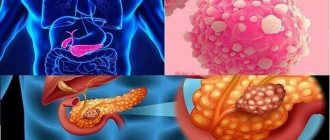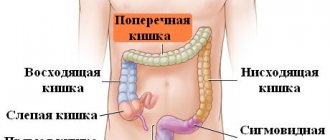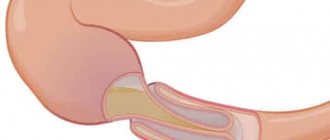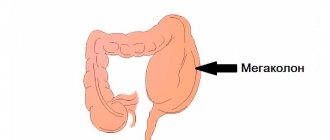The colon makes up approximately 4/5 of the total length of the large intestine. It has four sections: the ascending, transverse, descending and sigmoid colon. The latter passes into the rectum.
Colon cancer is one of the most common cancers. This pathology is usually referred to as “colon cancer.” Tumors of the colon and rectum are combined into one group of oncological diseases and are called colorectal cancer.
Typically, the appearance of a malignant tumor of the colon is preceded by the appearance of a benign neoplasm - a polyp. There are different types of polyps, and they have different potential for malignancy. The risks increase with age, so everyone 50 years of age and older is recommended to undergo a screening endoscopic examination - a colonoscopy.
Depending on the anatomical part of the tumor, cancer is classified into the transverse colon, ascending and descending colon, and sigmoid colon.
- Causes of colon cancer development
- Classification
- Stages of Colon Cancer
- How does cancer metastasize from the colon?
- Symptoms
- Complications of colon cancer
- Diagnostic methods
- Treatment methods
- Forecast
Causes of colon cancer development
It is impossible to say exactly why a particular person developed a malignant tumor in the colon. Cancer is always the result of a specific set of mutations in a cell, but what led to these mutations is a difficult question to answer.
There are some risk factors that increase the likelihood of developing colorectal cancer:
- Age. The risk of getting sick increases after 50 years. Apparently, this is due to the fact that over time, more and more genetic defects accumulate in the cells of the human body.
- Heredity. If your close relatives (parents, sisters, brothers, children) have been diagnosed with colon cancer, your risk is also increased.
- Unhealthy eating. The development of cancer is promoted by a “Western” diet, which contains a lot of red and processed meat, fast food, processed foods, and little fruits, vegetables and fiber. There are especially many carcinogens in food prepared by frying, grilling, or barbecuing.
- Low physical activity. People who lead a sedentary lifestyle are at increased risk.
- Excess weight. People who are overweight or obese are more likely to get colon cancer and have a worse prognosis.
- Smoking. The development of malignant tumors in the intestines is promoted by smoking and excessive alcohol consumption.
- Hereditary diseases. Parents can pass on certain mutations to their children that make them more susceptible to developing cancer. The most common hereditary diseases from this group are Lynch syndrome, as well as familial adenomatous polyposis.
- Chronic inflammation of the colon : ulcerative colitis, Crohn's disease.
None of these factors are 100% likely to cause colon cancer. Each of them only increases the risks to a certain extent. Some of these factors can be influenced, for example, start eating right, giving up alcohol and cigarettes, and playing sports.
Other factors, such as heredity, inflammatory bowel diseases, age, cannot be influenced. You need to be aware of your risks and get checked regularly. You can undergo screening using modern equipment at the European Clinic.
Book a consultation 24 hours a day
+7+7+78
Disease prevention
There is no specific prevention for this disease.
However, experts recommend:
- Eat right (limit the amount of fried, smoked, spicy and fatty foods, reduce the consumption of coffee, fast food and soda).
- Increase the amount of foods in your diet that contain fiber, dietary fiber (consume vegetables, fruits, buckwheat and corn cereals, whole grain bread, dairy products and vegetable oils).
- Increase the volume of fluid consumed to 2 liters per day.
- Be examined by a gastroenterologist using an endoscope at least once a year (especially for patients over 45-50 years of age. Remove tumors if they are detected.
- Reduce consumption of alcoholic beverages, quit smoking.
Sovinskaya Elena, medical observer
12, total, today
( 181 votes, average: 4.68 out of 5)
Proctitis: symptoms and treatment
Rectal prolapse: treatment at home
Related Posts
Classification
The most common type of colon cancer and colorectal cancer in general is adenocarcinoma . It develops from glandular cells that are found in the mucous membrane. Adenocarcinomas represent more than 96% of malignant neoplasms of the colon. In this group of tumors, a number of subgroups are distinguished. The most aggressive of them are mucinous and signet ring cell carcinoma . Such patients have the most unfavorable prognosis.
Stages of Colon Cancer
Colon cancer is classified into stages depending on the size and depth of the primary tumor (T), the presence of foci in regional lymph nodes (N) and distant metastases (M). There are five main stages:
- Stage 0 - “cancer in situ.” A small tumor that is located within the mucous membrane does not grow deeper.
- Stage I is a tumor that has grown into the submucosa or muscle layer of the intestinal wall.
- Stage II - a tumor that has grown into the deep layers of the colon wall (IIA), has grown through it and spread to neighboring organs (IIB), or there is a small tumor, as in stage I, and foci in 1-3 nearby lymph nodes (IIIC ).
- Stage III is divided into three substages: IIIA, IIIB and IIIC, depending on how deep the tumor has grown into the intestinal wall and how many lymph nodes are involved.
- Stage IV : There is metastasis in one organ (such as the liver or lungs) or in a group of lymph nodes that is far from the bowel (IVA), or there are metastases in more than one organ or group of lymph nodes (IVB), or the cancer has spread over the surface peritoneum (IVC). In this case, the size of the primary neoplasm and how deeply it has grown into the wall of the colon are not important.
How does cancer metastasize from the colon?
Colon cancer can spread to other organs in different ways:
- The implantation route is when cancer cells penetrate into neighboring organs that are in contact with the intestine and “spread” over the surface of the peritoneum.
- Some cancer cells break away from the primary tumor, enter the blood or lymph vessels, and migrate through them to the lymph nodes or other organs. Such routes of metastasis are called hematogenous and lymphogenous .
Most often, metastases from colon cancer are found in the lungs and liver, less often in the bones and brain.
Symptoms
Colon cancer often exists for a long time without causing any symptoms. But even when symptoms do occur, they are nonspecific and resemble those of many other diseases. If you are experiencing problems from this list, most likely you do not have cancer, but you should definitely visit a doctor and get tested:
- constipation or diarrhea that lasts for several days;
- change in the appearance of the stool: if it becomes dark, like tar, or thin, like a pencil;
- blood in the stool;
- after visiting the toilet there is a feeling that the intestines have not been completely emptied;
- pain, abdominal cramps;
- causeless weakness, feeling tired, unexplained weight loss.
Symptoms of inflammation of the large intestine
Large intestine inflammation symptoms of acute colitis can occur quite violently. In this case it is observed:
- bloating;
- sharp pain;
- mucous discharge from the anus;
- painful urge to defecate;
- diarrhea.
Also, these symptoms are accompanied by vomiting, high fever, general weakness, and sudden weight loss. In this case, the patient must definitely consult a doctor and conduct a full examination of all parts of the large intestine, its lower and upper parts, and, if necessary, the entire gastrointestinal tract.
Upon examination, they may reveal:
- swelling of the intestinal mucosa;
- thickening and hyperemia of the affected areas of the intestinal wall;
- localization of large amounts of mucus and purulent discharge;
- formation of erosions and ulcers on the intestinal mucosa;
- minor hemorrhages;
- A clinical blood test reveals high levels of ESR and leukocytes.
There may also be other clinical pictures of the disease. For example, for two to three weeks a person may experience discomfort with diarrhea, turbulence in the stomach and flatulence.
. But since such problems are insignificant, he does not pay attention to them, does not consider them important and does not associate them with the occurrence of a serious disease of the colon. Thus, the acute form becomes chronic.
Complications of colon cancer
If the tumor blocks the lumen of the colon, the patient develops intestinal obstruction . This condition manifests itself in the form of lack of stool, severe abdominal pain, nausea, vomiting, and severe deterioration in general condition. The patient immediately requires medical attention, otherwise necrosis (death) of a section of the intestine may occur and peritonitis will develop.
If the tumor leads to constant bleeding, anemia develops. The patient becomes pale, constantly experiences weakness, and is bothered by headaches and dizziness. In severe cases, a blood transfusion is required.
Metastasis of intestinal cancer to the liver threatens to disrupt the outflow of bile and develop obstructive jaundice - a condition in which the skin and mucous membranes acquire a yellowish tint, itching, abdominal pain, and general condition worsen. Until the flow of bile is restored, it becomes impossible to carry out active antitumor treatment.
A condition in which cancer cells spread over the surface of the peritoneum is called carcinomatosis , and ascites , an accumulation of fluid in the abdomen. This complication develops in stage IVC colon cancer. Ascites worsens the patient's condition, complicates treatment and has a sharply negative impact on the prognosis.
The European clinic has everything necessary to effectively combat complications of malignant tumors of the colon. In case of emergency, patients receive full treatment in the intensive care unit. Our surgeons perform palliative operations and install stents for intestinal obstruction. For obstructive jaundice, we perform drainage and stenting of the biliary tract. For ascites, our doctors perform laparocentesis (evacuation of fluid through a puncture), install peritoneal catheters, and conduct systemic and intraperitoneal chemotherapy.
For stage IVC colon cancer, when peritoneal carcinomatosis develops, surgeons at the European Clinic use an innovative treatment method - hyperthermic intraperitoneal chemotherapy (HIPEC). All large tumors are removed, then the abdominal cavity is washed with a chemotherapy solution heated to a certain temperature - this helps to destroy small lesions. According to the results of world practice, HIPEC can prolong the life of a cancer patient up to several years.
Book a consultation 24 hours a day
+7+7+78
Diagnostic methods
If a patient is concerned about symptoms that may indicate colon cancer, the doctor will first order an abdominal ultrasound and colonoscopy. These studies will help detect a tumor, and during a colonoscopy you can perform a biopsy - obtain a fragment of pathologically altered tissue and send it to the laboratory. A biopsy is the most accurate method for diagnosing cancer.
Colonoscopy is an effective screening method. It helps detect polyps and colon cancer in the early stages. It is recommended for all people over 50 years of age. At the European Clinic, colonoscopies are performed by expert doctors using the latest equipment from leading manufacturers. Our procedure takes place in a state of “medicated sleep,” so you will not experience any discomfort.
Once cancer is diagnosed, its stage must be determined. For this purpose, CT, MRI, and PET scans are used. Metastases in the lungs are detected using chest x-ray. If there are metastases in the liver, angiography is used - an X-ray examination, during which a contrast solution is injected into the blood vessels.
Additionally, the doctor may prescribe a stool test for occult blood, a general and biochemical blood test to detect anemia, and evaluate liver function. Blood tests for tumor markers are usually performed during treatment to monitor its effectiveness.
Differential diagnosis
The symptoms that occur with colon cancer can be disturbing in many other pathologies. Most often, a malignant tumor must be differentiated from diseases such as intestinal infections, chronic inflammatory processes, hemorrhoids, and irritable bowel syndrome.
Tumors of various parts of the intestine
The digestive tract consists of several parts. The longest section is the intestine. Its length is about 4 m. There are small and large intestines. A tumor can appear in any part. The greatest danger to people is cancer. A tumor is a neoplasm characterized by impaired cell differentiation.
The first signs of the disease may appear in the later stages, which worsens the health prognosis. In adults, the tumor is most often localized in the colon. Tumors can be benign or malignant. They have their own characteristics. Malignant neoplasms are distinguished by the following signs:
- complete loss of cells' ability to differentiate normally;
- atypia;
- the ability to give distant metastases;
- germination of surrounding tissues in later stages;
- fast development;
- aggressive growth;
- frequent relapses.
Cancer has all these properties. Benign intestinal tumors are characterized by slow growth, partial ability for cellular differentiation, absence of metastases and rare relapses. The prognosis for them is more favorable. They never grow into other organs, but can compress them.
Types and stages of tumors
Neoplasms are very different. The most common benign tumors are:
- leiomyomas;
- adenomas;
- angiomas;
- hemangiomas;
- lymphangiomas;
- lipomas;
- fibroids;
- Schwannomas.
The most common is leiomyoma. It is diagnosed in 30-35% of patients. Adenoma is slightly less common. It can be tubular, villous and mixed. An adenoma develops from the epithelial (glandular) tissue of the intestine and resembles the shape of a polyp with a stalk. Often an adenoma undergoes malignant degeneration into cancer.
Intestinal tumors develop mainly in older people. The peak incidence is between 40 and 70 years of age. There are benign tumors that develop from connective tissue, these include leiomyoma. It resembles a node without a capsule. Leiomyoma is localized in the submucosal layer of the intestinal wall.
Sometimes benign tumors develop from nerve tissue and are called schwannomas. All neoplasms are divided into congenital and acquired. The first group includes lymphangiomas and hemangiomas, which are formed from blood vessels. These neoplasms are dangerous because they can cause intestinal bleeding. Benign tumors can grow exophytically (into the intestinal lumen) or endophytically (deeper).
Among malignant neoplasms, the most frequently detected are leiomyosarcoma, angiosarcoma, lymphoma, carcinoid and cancer. They develop from different tissues. Sometimes a malignant form of schwannoma develops. The most commonly diagnosed pathology is colorectal cancer, which affects the large intestine. Cancer occurs in 4 stages. Distant metastases indicate an advanced tumor; in this case, surgery is ineffective.
Main etiological factors
No one knows why neoplasms occur in women and men. The exact reasons for the development of tumors have not been established. The following risk factors are identified:
- poor nutrition;
- smoking;
- alcoholism;
- contact with carcinogenic compounds;
- the presence of precancerous diseases (peptic ulcer, polyps);
- burdened heredity;
- celiac disease;
- ulcerative colitis and enteritis;
- elderly age;
- chronic constipation;
- polyposis syndromes (Gardner);
- physical inactivity;
- mechanical damage to the intestine;
- parasitic diseases (helminthiasis);
- autoimmune disorders;
- Crohn's disease;
- acute and chronic intestinal infections;
- diverticulitis.
The duodenum is often affected by exposure to bile and pancreatic juice. Risk factors include the presence of familial polyposis. Adenomatous polyps are the most dangerous; they most often degenerate into cancer. Malignant intestinal tumors can develop against the background of benign neoplasms. This is observed in people who do not see a doctor for a long time.
The condition of the intestines largely depends on the nature of the diet. Eating large amounts of animal fats, lack of dietary fiber and vitamins, alcoholism, addiction to spicy and fried foods, excess meat in the diet - all this increases the likelihood of tumors. Carcinogens are of no small importance. These substances can come from food or air.
Food additives (dyes, preservatives) have an adverse effect on the intestines. The risk of developing cancer is higher among people who work in hazardous working conditions, as well as among employees of the chemical industry.
Signs of benign neoplasms
If there is a tumor in the intestine, there are often no symptoms in the early stages. Often the disease is detected by chance. Benign tumors of the small intestine in women and men are manifested by the following symptoms:
- nausea;
- belching;
- periodic vomiting;
- increased gas formation;
- decreased appetite;
- loose stool or constipation;
- intermittent pain.
If the duodenal papilla is damaged, jaundice may develop. Symptoms are largely determined by the location of the tumor. If the small intestine is affected, symptoms include pain in the left side of the abdomen and near the navel, which is intermittent and dull. In women and men, the tumor is often localized in the ileum, and pain is felt in the right lower abdomen.
Symptoms in women and men are most severe when the tumor becomes large. This can cause bleeding and intestinal obstruction. In this case, coagulated blood is found in the vomit and stool. This symptom is most often observed with vascular neoplasms (hemangiomas).
Adenomas and polyps cause intestinal obstruction. It manifests itself as bloating and fecal retention. Extraintestinal manifestations such as darkening of the skin, hair loss and nail damage are sometimes observed. This is possible against the background of adenomatous polyps. Benign neoplasms are not accompanied by symptoms of intoxication.
If the tumor is localized in the colon area, the following clinical signs are observed:
- stool instability;
- pale skin;
- weakness;
- discomfort in the lower abdomen;
- the appearance of blood in the stool.
Most often there are no symptoms. In the presence of villous tumors, the water and electrolyte balance in the body is often disturbed. Large tumors cause constipation and chronic intestinal obstruction. Signs of pernicious anemia are often observed.
Manifestations of malignant tumors
The cancer process is more severe. Malignant tumors of the small intestine are manifested by pain, weight loss, weakness, fatigue, and bleeding. With lymphoma, perforation is possible. It manifests itself as acute, cramping pain. 10% of patients have no symptoms. Adenocarcinomas and carcinoids, if not diagnosed in a timely manner, lead to blockage of the intestinal lumen.
In lymphoma and leiomyosarcoma, a large tumor can be palpated through the abdominal wall. Carcinoid is manifested by diarrhea, a feeling of a rush of blood to the body, and shortness of breath. Bronchospasm often develops. A complication of carcinoid is the development of heart failure. The first symptoms appear 6-12 months after the tumor begins to grow.
Colorectal cancer is the most commonly diagnosed cancer. In the early stages it manifests itself with the following symptoms:
- bloody discharge during bowel movements;
- pain during bowel movements;
- the presence of a large amount of mucus in the stool;
- pain in the lower abdomen on the left or right;
- constipation;
- diarrhea;
- signs of anemia.
In later stages, intoxication develops. This is a manifestation of advanced cancer. Intoxication is manifested by depression, weakness, loss of strength, pallor, yellowing or bluish skin, dry mucous membranes, fever, night sweats, nausea, and repeated vomiting. In case of damage to distant organs (lungs, pancreas, bones, spine, liver), extraintestinal symptoms appear.
Treatment methods
There are different treatment options available for colon cancer. The doctor chooses the optimal tactics, depending on the stage of the malignant tumor, its location, the general condition of the patient, the presence of certain complications, and concomitant diseases. They perform surgical interventions, use different types of antitumor drugs, and conduct courses of radiation therapy.
Chemotherapy
Chemotherapy for malignant tumors of the colon can have different goals:
- Neoadjuvant chemotherapy is given before surgery to shrink the tumor and make it easier to remove.
- Adjuvant chemotherapy is given after surgery to kill any remaining cancer cells and reduce the risk of recurrence.
- as the main treatment method for advanced stages of cancer for palliative purposes.
For malignant neoplasms of the colon, different types of chemotherapy drugs are used: capecitabine, 5-fluorouracil, oxaliplatin, irinotecan, trifluridine/tipiracil (combination drug). Most often, two or more drugs are used simultaneously, this helps to increase the effectiveness of treatment.
Targeted drugs have a more targeted effect compared to classical chemotherapy drugs: they are aimed at specific target molecules that help cancer cells multiply uncontrollably and maintain their vital functions. Most often, two groups of targeted drugs are used for malignant intestinal tumors:
- VEGF inhibitors are substances that cancer cells use to stimulate angiogenesis (the formation of new blood vessels). This group includes: Ziv-aflibercept (Zaltrap), Ramucirumab (Ciramza), Bevacizumab (Avastin). They are used for advanced colon cancer, administered intravenously every 2 or 3 weeks, usually combined with chemotherapy.
- Inhibitors of EGFR , a receptor protein that is found on the surface of cancer cells and causes them to multiply uncontrollably. This group includes drugs such as Cetuximab (Erbitux), Panitumumab (Vectibix). EGFR inhibitors are administered intravenously once a week or every other week.
In some cases, drugs from the group of checkpoint inhibitors . They block molecules that prevent the immune system from recognizing and attacking cancer cells. This group of drugs includes: Pembrolizumab (Keytruda), Nivolumab (Opdivo), Ipilimumab (Yervoy). They are usually used for inoperable, metastatic cancer, when chemotherapy is ineffective if there is a relapse.
In order to figure out which drugs will be effective in a particular patient, you need to understand what properties cancer cells have, what mutations have occurred in them, and due to what substances they have acquired the ability to reproduce uncontrollably. Molecular genetic analysis helps with this - compiling a “molecular portrait” of cancer. Thanks to our cooperation with leading foreign laboratories, such a study can be performed at the European Clinic. We know how to increase the effectiveness of antitumor treatment and what to do if it stops helping.
Surgery
In some cases (stage 0, cancer in situ; sometimes stage I), colon cancer can be removed during a colonoscopy. Unfortunately, this opportunity is rarely available. Most often, you have to perform a colectomy - partial or complete removal of the colon. The extent of surgical intervention depends on the location and size of the tumor. Typically, at least 12 nearby lymph nodes are removed at the same time. The remaining ends of the intestine are sewn together and an anastomosis .
Colectomy can be performed openly (through an incision) or laparoscopically (through punctures in the abdominal wall).
Sometimes the anastomosis cannot be performed immediately. In such cases, a temporary colostomy or ileostomy - a section of the colon or ileum is sutured to the skin and an opening is created for the passage of stool. The stoma is subsequently closed.
If the tumor blocks the intestinal lumen and cannot be removed, a permanent colostomy is performed. Intestinal patency can be restored using a stent - a metal frame in the form of a hollow cylinder with a mesh wall. Such operations are called palliative : they are not aimed at removing cancer, but at combating symptoms and improving the patient’s condition.
Surgeons at the European Clinic perform various types of radical and palliative interventions. The specialists in our endoscopy department have extensive experience in installing stents in the intestine, bile ducts and other hollow organs. The Department of Interventional Surgery performs radiofrequency ablation and chemoembolization for liver metastases.
Radiation therapy
Radiation therapy may be given before ( neoadjuvant ), after ( adjuvant ) colon surgery, or as the primary treatment for metastatic cancer to control symptoms.
When radiation therapy is combined with chemotherapy, the treatment is called chemoradiotherapy .
Treatment of tumors in adults
Tumor formations in adults are treated differently. It all depends on the characteristics of the tumor, the body, the patient’s age, and the presence of concomitant pathologies.
Only a qualified doctor has the right to engage in therapy. If the disease is benign in nature, then treatment is reduced to surgical removal, the tumor itself is excised while preserving the intestines.
After this, antibacterial therapy is prescribed to prevent complications in the form of infection; the prognosis for life and health in such patients is favorable.
Malignant tumors are treated with combined methods: chemotherapy, radiation therapy, surgery. Initially, they resort to chemotherapy, they kill cancer cells.
Under the influence of polychemotherapy, the tumor should decrease in size and stop actively dividing, then surgery will begin.
The tumor is excised along with a section of the intestine and a block of lymph nodes, and if necessary, gamma irradiation of the damaged area is prescribed.
Tumor removal operations
In order to determine the type of tumor, a piece of it is taken during surgery for cytological examination. They quickly process and evaluate, the histologist gives his conclusion.
If the tumor is benign without cell atypia, then only it is removed, without a section of the intestine; if the tumor is malignant, then intestinal resection is resorted to.
In this case, a large area of the affected intestine is removed along with the tumor and lymph nodes; when the cancer is in the lower parts of the colon, then abdominal-anal extirpation is used - this is the complete removal of several parts of the organ with the tumor and metastases.
A stoma is placed on the anterior abdominal wall for emptying.
Life prognosis after surgery
If the disease is not related to cancer etiology, then the prognosis for life and health is favorable. Such patients recover completely and return to their normal lives.
If cancer is detected, the prognosis depends on the stage of the process; after radical resection at stages 1 and 2, survival is 80%.
At stages 3 and 4 there is a high risk of developing metastases and complications. Surgery does not always help; after surgery, the five-year survival rate is 30-10% - an unfavorable prognosis for life and work capacity.











